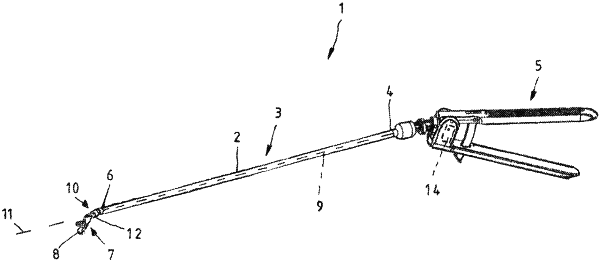| CPC A61B 17/29 (2013.01) [A61B 2017/00323 (2013.01); A61B 2017/2902 (2013.01); A61B 2017/2927 (2013.01)] | 3 Claims |

|
1. A medical instrument with a hollow shaft comprising a hollow shaft tube, an actuating unit arranged at the proximal end of the shaft and an instrument tip with an instrument arranged at the distal end of the shaft, wherein the instrument can be actuated via an actuating element mounted axially displaceably in the shaft, the actuating element being in an operative connection with the actuating unit on the proximal side and the instrument tip being pivotable relative to the longitudinal axis of the shaft via a joint mechanism;
the joint mechanism having pivoting members arranged on the distal end of the shaft are connected with a proximal-side drive via steering wires arranged inside the hollow shaft tube of the shaft and running in the longitudinal direction of the shaft in such a way that a movement of the proximal-side drive causes a corresponding relative movement of the distal-side pivoting members and thus a pivoting of the instrument tip as well as with a trigger mechanism with which the steering wires can be brought into a relaxed state that releases the articulation of the instrument tip, independently from the actuation of the proximal-side drive,
characterized in that,
the distal-side pivoting members and thus also the instrument tip stay in a fixed unmovable position between each movement of the proximal-side drive free of the use of a locking mechanism and in that,
the trigger mechanism comprises a mechanical trigger mechanism enabling a free movement of the pivoting members in case of failure of the proximal side drive, wherein the hollow shaft tube of the shaft which coaxially surrounds the steering wires can be displaced in the direction of the longitudinal axis of the shaft for relaxing the steering wires through the use of the trigger mechanism;
characterized in that the trigger mechanism is designed as a mechanical clamping mechanism; and
characterized in that the mechanical clamping mechanism comprises two articulated levers and, wherein a first lever is pivotably mounted with its free end on the hollow shaft tube, and a second lever is pivotably mounted with its free end on the actuating unit.
|